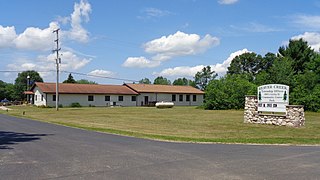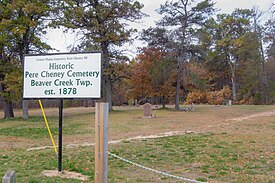
The Au Sable River is a 138-mile-long (222 km) river in the Lower Peninsula of the U.S. state of Michigan. Rising in the Northern Lower Peninsula, the river flows in a generally southeasterly direction to its mouth at Lake Huron at the communities of Au Sable and Oscoda. It is considered one of the best brown trout fisheries east of the Rockies and has been designated a blue ribbon trout stream by the Michigan Department of Natural Resources. A map from 1795 located in the United States Gazetteer calls it the Beauais River. In French, the river is called the Rivière au sable, literally "Sand River".

Oscoda County is a county in the U.S. state of Michigan. As of the 2020 census, the population was 8,219, making it the least populous county in the Lower Peninsula, and the sixth-least populous county in the entire state. The county seat is Mio, an unincorporated community near the center of the county.

Kalkaska County is located in the U.S. state of Michigan. As of the 2020 census, its population was 17,939. The county seat is Kalkaska.

Crawford County is a county in the U.S. state of Michigan. Its population was 12,988 as of the 2020 census. The county seat of Crawford County is Grayling, the county's only incorporated community.

Beaver Creek Township is a civil township of Crawford County in the U.S. state of Michigan. As of the 2020 census, the township population was 1,515.

Grayling is a city and the county seat of Crawford County in the U.S. state of Michigan. It is the only incorporated community in Crawford County. The population was 1,884 at the 2010 census. The city is surrounded by Grayling Charter Township, but the two are administered autonomously.

Grayling Charter Township is a charter township of Crawford County in the U.S. state of Michigan. The population was 5,642 as of the 2020 census, down from 5,827 at the 2010 census. The city of Grayling is surrounded by Grayling Charter Township, but both are administered autonomously.
Beaver Township is a civil township of Newaygo County in the U.S. state of Michigan. As of the 2020 census, the township population was 463.

Beaver Township is a township in Crawford County, Pennsylvania, United States. The population was 794 at the 2020 census.
New Burlington is a former town located in Chester Township in the northwestern corner of Clinton County, Ohio, off Ohio State Route 380. The GNIS classifies it as a populated place. It was acquired by the United States federal government when Caesar Creek was dammed and a reservoir created in the 1970s.

Walton, often referred to as Walton Junction, is an unincorporated community in the northern Lower Peninsula of the U.S. state of Michigan. The community is located within Fife Lake Township, Grand Traverse County, and lies immediately north of the Wexford County line.

Northern Michigan, also known as Northern Lower Michigan, is a region of the U.S. state of Michigan. A popular tourist destination, it is home to several small- to medium-sized cities, extensive state and national forests, lakes and rivers, and a large portion of Great Lakes shoreline. The region has a significant seasonal population much like other regions that depend on tourism as their main industry. Northern Lower Michigan is distinct from the more northerly Upper Peninsula and Isle Royale, which are also located in "northern" Michigan. In the northernmost 21 counties in the Lower Peninsula of Michigan, the total population of the region is 506,658 people.

Moonville is a ghost town in southeastern Brown Township, Vinton County, Ohio, United States. Little remains of this former mining community except a few foundations, a cemetery, and an abandoned railroad tunnel which is the subject of numerous ghost stories.

Stull is an unincorporated community in Douglas County, Kansas, United States. Founded in 1857, the settlement was initially known as Deer Creek until it was renamed after its only postmaster, Sylvester Stull. As of 2018, only a handful of structures remain in the area.

Comins is an unincorporated community in Oscoda County in the U.S. state of Michigan. The community is located within Clinton Township. As an unincorporated community, Comins has no legally defined boundaries or population statistics of its own but does have its own post office with the 48619 ZIP Code.
The ghost of Minnie Quay is a legend in the paranormal circles of Michigan. The legend stems from a small foresting town in the eastern region of Michigan, known as The Thumb, called Forester, in present-day Forester Township.

Luzerne is an unincorporated community in Oscoda County in the U.S. state of Michigan. The community is located within Big Creek Township. As an unincorporated community, Luzerne has no legally defined boundaries or population statistics of its own but does have its own post office with the 48636 ZIP Code.
The Crawford County Avalanche is a weekly newspaper and website based in Grayling, Michigan published on Thursdays. It calls itself "Grayling's Hometown Newspaper Since 1879" and is the newspaper of record for Crawford County for 144 years. The Chronicling America project of the Library of Congress has images of the newspaper online for the years 1879–1900.

















